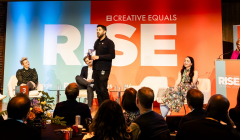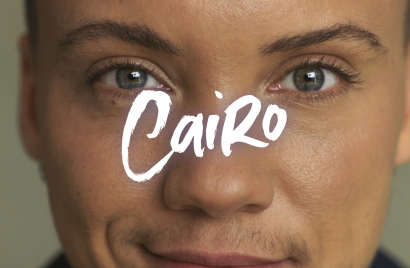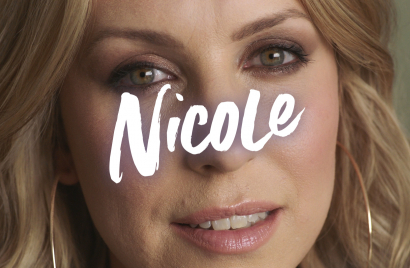
Are we leaving men and boys behind?
At Creative Equal’s RISE event, industry leaders consider how to reframe boys and men in marketing

Starbucks and Iris’ award-winning ad demonstrates the massive power of the creative industries to come together to drive culture through authentic representation.

The most powerful basis for an advertising campaign is one that is rooted in truth, the marketing firepower of the lived experience. Build a campaign on that and you have a much greater chance of it resonating with your audience.
It was this lived experience that provided the basis for Starbucks award-winning campaign, ‘What’s your name’ created by Iris. The campaign was the winner of this year’s Channel 4 Diversity in Advertising Award which invited brands to explore how better to represent the LGBTQ+ community.
Neil Littler, Head of Marketing, Digital and Product at Starbucks UK explains, there was a moment during the research stage where a powerful insight stood out to them: “Writing a name on a Starbucks cup is a moment of connection that we have with our customers but as our research uncovered, it’s also a clear mark of acceptance for the transgender community.”
‘What’s your name’ embodies that insight as we meet a young trans boy struggling to navigate his way through a world that insists on still referring to him by his deadname, or the name he was given at birth.
It is only when he walks into a Starbucks store and hears his named called out that he feels truly seen. Littler expands by adding that “Our stores offer a safe space for individuals transitioning to use their new names and be recognised as they want to be.”
As Raj Thambirajah, Strategy Director at Iris, explains: “The insight was very specific but as we kept finding out, was very true. There were a lot of people identifying with it.”
If you have a committee where everybody’s committed to the same goal, it just makes the process and the work all the better.
Raj Thambirajah
A huge part of the success of the campaign comes down to the collaborative approach taken between client and agency. As Littler explains, entering the Channel 4 competition was “the first time I’ve had to pitch with an agency.” Sharing the moment Iris first showed him their ideas, he says, “When I saw the initial concepts, it was probably one of the easiest yeses I’ve ever had to give as a client.”
Thambirajah adds that the idea wasn’t just born out of one creative team or one person: “Throughout the whole process it was always a roundtable process together with Neil and the team. They often say things can’t be done by committee, but I think if you have a committee where everybody’s committed to the same goal, it just makes the process and the work all the better.”
The team also worked alongside Mermaids, the charity that provides support for young transgender and gender diverse people and their families. Thambirajah acknowledges that, due to the sensitivity of the campaign’s subject matter, specialist partners were essential: “Mermaids have always been there, pretty much every step of the way. Always offering invaluable insight, counsel and support and guidance.” The team were in continuous conversation, with the charity acting as a “real inspiration and sounding board.”
The charity was a vital ingredient in the success of this campaign, offering direct support, as well as being part of the casting process. They also provided guidance on set, something Thambirajah says was invaluable because the team were working with real people, not actors playing a part. Mermaids, he adds, were “offering a duty of care to everybody that was involved…We had to be respectful of the fact that these were real people with real emotions.”
Starbucks has a long-standing relationship with the LGBT community says Littler but this campaign, he explains, “was a real opportunity to activate that in the UK in very real ways.” Mermaids offered Starbucks the opportunity to support the organisation’s helpline which helps those that need it the most: the young transgender community and their families.
What is apparent when you watch the ‘What’s your name’ TV slot is that a sensitive and emotive experience has been handled with real integrity and respect. Part of that, as Thambirajah explains, comes from the team’s decision to work with real people not actors to tell a very real story.
“You can probably see how that manifests in the work,” says Thambirajah. “Because what you have is not so much emotions that are created or manifested; they’re probably being remembered and relived to a certain extent.” These emotions are powerfully communicated through the nuanced performance of the protagonist James.
Throughout the ad, James never says much; the power comes through in what is expressed on his face, from the pain at being called by his deadname by family and delivery drivers through to the joy when he’s referred to by the name he’s chosen in Starbucks. The ad captures that subtle but powerful emotional shift right up to the little smile at the end. “It feels real because it probably was,” adds Thambirajah.
He tells us that the ad’s director Nick Jack Davies spent a lot of time getting to know the cast, “almost immersing himself in their world.” He adds that this meant the ad shared “the story that [the trans community] generally wanted to tell.”
A fear throughout the process was that they wouldn’t communicate the story effectively, that they would do a disservice to a subject that is sensitive and, as Thambirajah adds, “quite a tender one.” The team were conscious that they wanted to tell the story authentically with respect and honesty.
What remained vital to remember was that the story they were telling was real; “we weren’t manufacturing it,” explains Thambirajah. Part of that was checking back in with their partners in Mermaids throughout the process, to ensure that they all stayed true to the cause they were promoting. It was also, adds Thambirajah “knowing that there will be different sides of different perspectives but having the conviction to stand behind what we believe in.
The importance of the Channel 4 Diversity in Advertising Award can’t be underestimated as both Littler and Thambirajah emphasise. The award is a commitment to improving the diversity in advertising by offering a brand £1 million worth of airtime.
This year the brief was to address the lack of representation and stereotyping of the LGBT+ community in advertising, something that Starbucks felt inspired by. The theme was chosen off the back of research commissioned by Channel 4 and YouGov that revealed just 3% of those featured in ads are from the LGBT+ community; 6 in 10 LGBT+ people interviewed feel they’re not well represented in advertising.
For Littler, the brief felt like “the perfect issue to focus on for our first major UK TV campaign,” to emphasise the true “mission and values” of the brand within the UK. He also highlights the fact that the award “really allowed us to amplify that particular campaign to a much wider audience with a much greater reach.” Indeed, the Mermaids helpline team are already reporting an increase in contact off the back of the campaign, people the charity perhaps would not have connected with, adds Littler, if it wasn’t for the reach of the campaign.
Thambirajah feels that the process also proved to be emotionally enlightening from a personal perspective as well: “For me, [the award process] was a real roller coaster. It was a journey of serendipity…a real journey of growth.” He adds though that watching the campaign coming together alongside the agency’s partners, gave the team “a pretty good air of confidence in that we had something quite real and true.”
Littler feels very proud of the winning work and grateful to the judging team that awarded them: “we were very humbled by that judging panel and Channel 4 putting their faith in us to be able to tell it with authenticity as well.” As Thambirajah adds, “it’s almost a gift, especially when it comes to marketing, to find a real way to connect a brand with an audience in a really meaningful way.”
It helps [Mermaids] to help more people and that’s what we’re really proud of.
Neil Littler
The Starbucks and Iris team were adamant that the campaign wouldn’t just live on TV; that it would carry the stories further afield and provide support to Mermaids in turn. Littler explains: “The partnership between Starbucks and Mermaids will last beyond the advertising campaign. The funding from Starbucks will enable Mermaids to put an additional helpline operator to extend the Mermaids webchat opening hours by nine hours every day.”
In addition to raising funds for the charity’s helpline, Starbucks have also created a mermaid tail-shaped biscuit that customers can buy in stores around the UK. A portion of every sale will go directly to the charity. As Littler says of the money raised, “It helps [Mermaids] to help more people and that’s what we’re really proud of.”
Alongside the TV slot, Iris created a series of social posts entitled Moving Portraits featuring other members of the trans community sourced through the original casting process. Thambirajah explains that it was important for the team to convey a breadth of story: “We are not just telling a story about a community; we’re actually giving them a platform for them to voice something that they’ve been wanting to tell.”
While the power of the TV slot came through directly reflecting the original insight, that of being recognised, the social posts, explains Thambirajah, go beyond that, to “allow people to tell the deeper story behind their name and how they came to choose it.” The reason they’ve chosen to run the portraits on social is in the hope that they will only open up the conversation, inviting other members of the trans community to share their stories.
What has been important since the campaign launched, for Thambirajah is that “the campaign has been validated to a certain extent by Mermaids.” The charity asked their community to come forward if they’d had similar experiences; 30 people called in within the first 24 hours “saying that this was reflective of them and the journey they’ve been on,” he adds.
Picking up a coffee with your name on it is such an everyday part of people’s lives that, if it’s not your lived experience, you’d never recognise the significance that such a simple act can contain.
The power of this ad is that it gives people an understanding of another community’s experience, something the team were able to do because they both listened to and engaged with the community at the heart of the story they set out to tell. What is clear is that the truth of the insight carries through the campaign, in the power of the unspoken emotions written on a young person’s face and the simple act of feeling recognised for who they really are.


Starbucks, 'Moving Portraits' by Iris
Looks like you need to create a Creativebrief account to perform this action.
Create account Sign inLooks like you need to create a Creativebrief account to perform this action.
Create account Sign in